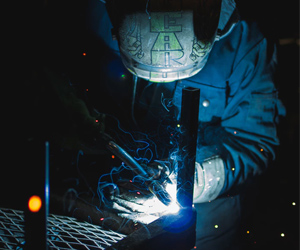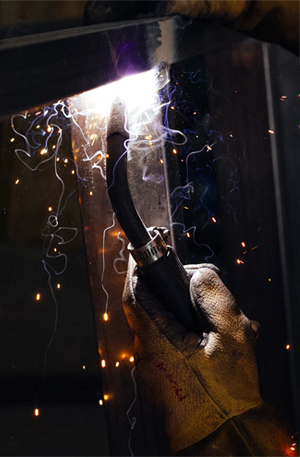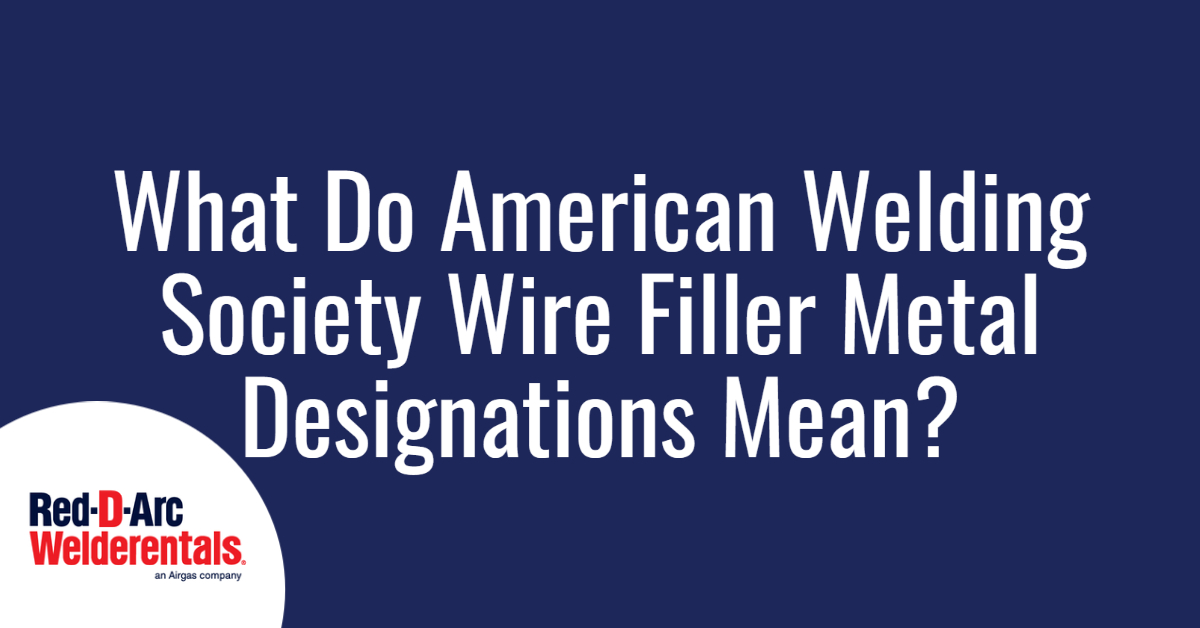Selecting Welding Wire

Welder wire classification may seem daunting at first, but they are actually rather straightforward. American Welding Society (AWS) classifies filler metals for arc welding processes, and each filler metal has its classification. However, some filler metals share the classification name for more than one welding process, while others are classified according to the welding process. For example, some wires for TIG welding share the same classification as spools of MIG wires, while flux-cored or metal-cored wires have unique designations.
AWS Filler Metal Specifications By Material and Welding Process
There are many AWS filler metal specifications, but the list below outlines the most often applied filler metals and their AWS specifications:
- A5.18 Specification for carbon steel electrodes for gas shielded arc welding
- A5.20 Specification for carbon steel electrodes for flux cored arc welding
- A5.9 Specification for bare stainless steel welding electrodes and rods
- A5.22 Specification for stainless steel flux cored and metal cored welding electrodes
AWS also has specifications for aluminum, low-alloy steel, cast iron, nickel alloys, copper, and other materials. However, solid, metal-cored, and flux-cored wires are most often used to weld steel and stainless steel. So, this guide below will focus on these two materials and different gas-shielded and self-shielded wires.
How To Read AWS Filler Wire Specifications
American Welding Society filler wire specifications follow a uniform pattern for their filler metal designations. While the AWS alpha-numerical designations may seem intimidating initially, they are relatively easy to read once you get the hang of the AWS system.
We will discuss each designation on examples soon. But let’s quickly go through the essential alpha-numerical markers you can find on solid, flux-cored, and metal-cored wires.
- The first letter(s) can be “E,” as electrode, “R” as welding rod, or an “EC,” which indicates a metal-cored electrode.
- Solid carbon steel electrodes indicate a tensile strength in 1000 increments after the first letter. Usually, it’s “70,” as 70,000psi. However, stainless steel electrodes designate the composition of the weld metal after the first letter. For example, “308” austenitic stainless steel filler metal alloy.
- Carbon steel electrodes have the letter “S,” which indicates that the filler metal is solid, while the letter “C” indicates a composite. What follows is one of the following digits: 2, 3, 4, 6, 7, or letters “G” or “GS,” and these indicate the chemical composition. “GS” means that the filler metal is for single-pass welds only.
- The letter “T” indicates that the wire is a flux-cored welding electrode. The number after this letter designates the recommended welding position — “0” means flat and horizontal, while “1” is an all-position electrode.
- Stainless steel wires may also have letters “L, H, and LR” in their name. The letter “L” indicates a lower carbon content, the letter “H” indicates higher carbon content, and the letters “LR” indicate low residuals.
Solid Welding Wire Electrode Designation Example:

If you’ve ever picked up a MIG torch, chances are high that you’ve welded with the ER70S-6 solid welding wire. This wire is widely used for repair jobs and joining thin sheet metal, especially when welding slightly contaminated base materials. The added silicon provides better puddle fluidity and higher resistance to weld contamination. So, let’s see how to read its specification from left to right:
- E = electrode – can be a carrier of electricity.
- R = rod – it does not have to be an electrode to be used as weld metal. An example would be cutting the solid wire into 50 cm sections for gas tungsten arc welding (GTAW).
- 70 = 70,000 as-welded tensile strength in pounds per square inch.
- S = solid, not tubular.
- -6 = variation of chemical composition; for instance, an ER70S-6 wire has more silicon than an ER70S-2.
Stainless Steel Solid Welding Wire Electrode Designation Example:
If you weld stainless steel, you know about the ER308LSi welding wires. This filler metal is often used for its smooth arc characteristics thanks to its higher silicon content. The ER308LSi is an excellent choice for applications where finish quality and aesthetics are paramount. But let’s see how to read its specs from left to right:
- E = electrode – it conducts electricity.
- R = rod – it does not have to be an electrode to be used as weld metal. An example would be cutting the solid wire into 50 cm sections for gas tungsten arc welding (GTAW).
- 308 = The stainless steel alloy of the welding wire.
- L = low carbon, as opposed to “H,” which would be high carbon.
- Si = higher than normal amounts of silicon improves the wetting of the weld puddle.
Metal-Cored Arc Welding Wire Example:
A common low-carbon steel metal-cored arc welding wire is E70C-6M-H4, designed for high travel speed applications with minimum spatter, provides excellent arc for automated and manual welding. Its specs from left to right are:
- E* = electrode – it conducts electricity.
- *Note that there is no “R” following the “E” in E70C-6M-H4; this is because this wire must be used as an electrode.
- 70 = 70,000 as-welded tensile strength in pounds per square inch.
- C = composite, as opposed to solid.
- -6 = variation of chemical composition.
- M = shielding gas type; “M” means a blend (typically 75% Argon/25% CO2), and “C” designates 100% CO2.
- -H4 = maximum diffusible hydrogen level of 4 ml/100 grams of weld metal.
Gas-Shielded Flux-Cored Welding Wire Example:
The E70T-1C-JH8 is typically used for heavy-duty structural fabrication and shipbuilding and makes a good example of a gas-shielded flux-cored arc welding wire. It offers exceptional arc performance and bead appearance at high deposition rates. This wire generates low fumes and works with a 100% CO2 shielding gas, which reduces operational costs and improves weld penetration. So, let’s see how to read its specs from left to right:
- E* = electrode; this means that it is capable of being a carrier of electricity.
- *Note that there is no “R” following the “E” in E70T-1C-JH8; this is because this wire must be used as an electrode.
- 7 = 70,000 as-welded tensile strength in pounds per square inch.
- 0 = With flux-cored arc welding wires, the digit after the as-welded tensile strength designation is used to define the welding position capability of the wire; a “0” indicates flat or horizontal only, whereas a “1” indicates all positions, including vertical and overhead.
- T = tubular, as opposed to solid.
- -1 = operating attributes; can help determine the electrical polarity that should be used for best performance and other welding attributes relative to other flux-cored wires
- C = shielding gas type; “C” designates 100% CO2, “M” means a blend (typically 75% Argon/25% CO2).
- -J = indicates that the welding wire is notable for its impact strength and toughness at cold temperatures relative to wires without the “J” designation.
- H8 = maximum diffusible hydrogen level of 8 ml/100 grams of weld metal.
Self-Shielded Flux-Cored Welding Wire Example:
A typical example of a self-shielded flux-cored wire is E71T-14. With its soft, consistent arc and fast travel speed abilities, the E71T-14 is used in many automated and manual welding applications. Reading its specification from left to right is similar to the gas-shielded flux-cored wire above, but it doesn’t have a designation for the shielding gas.
- E* = electrode – this means that it can be a carrier of electricity.
- *Note that there is no “R” following the “E” in E71T-14; this is because this wire must be used as an electrode.
- 7 = 70,000 as-welded tensile strength in pounds per square inch.
- 1 = The digit after the as-welded tensile strength designation defines the welding position capability of the wire; a “0” indicates flat or horizontal only, while “1” indicates all positions, including vertical and overhead.
- T = tubular, as opposed to “S,” which means solid; the flux-cored wire must be tubular because the flux is deposited in its core.
- -14 = operating characteristics; this is an arbitrary number used to relate to other flux-cored wires.

Get Your Equipment From Red-D-Arc
You can find any welding wire you need here, including wires for stainless steel, bronze, and aluminum alloys. We stock wires from Lincoln Electric, Hobart, ESAB, and other renowned manufacturers for your peace of mind — clean, uniform, and protected from oxidation wires provide far better welding results than off-brands with questionable production quality.
Investing in welding equipment is a crucial investment for any welder, whether you’re a professional welder or a DIY enthusiast. With Red-D-Arc, you can rest assured that you are getting high-quality equipment from top manufacturers. Whether you need welding machines, wire, or other accessories, Red-D-Arc has a vast selection to choose from. Contact us today to learn more.
You can find a range of welding wire options here.








Leave a Reply